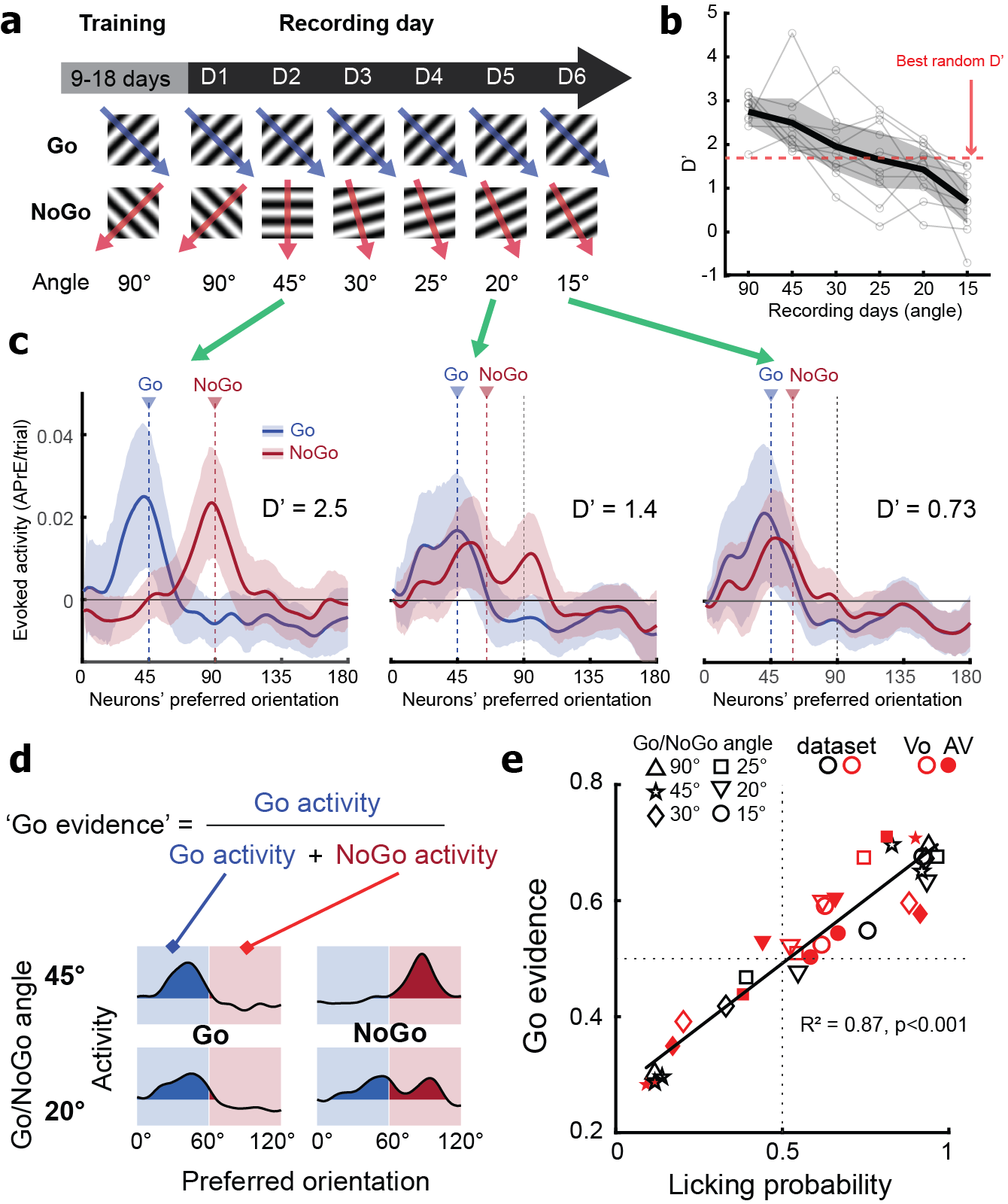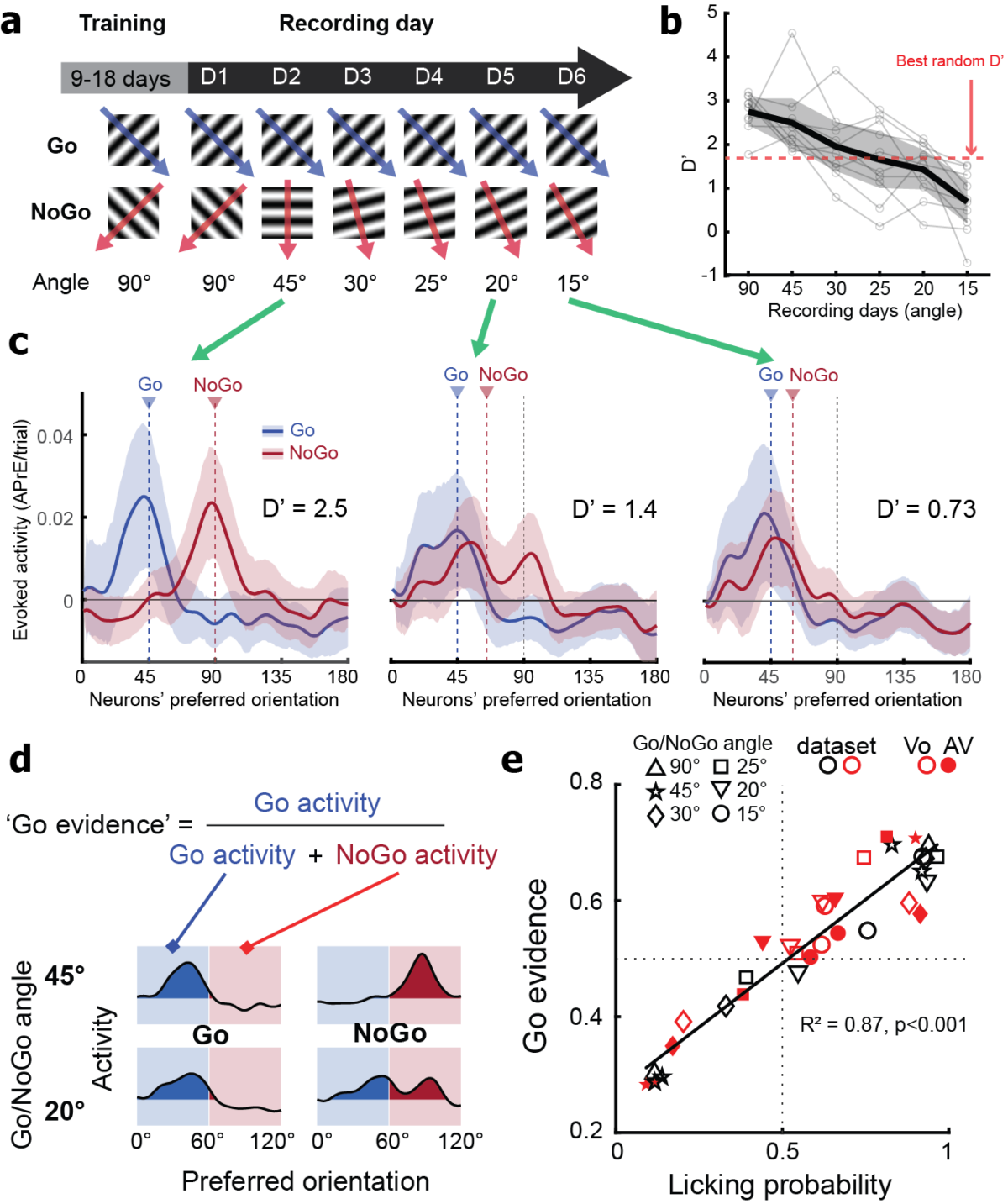Categorization in the Primary Visual Cortex
Corbo, J., Erkat O.B., McClure J.M., Khdour H.Y., and Polack P-O. (2022) Category representations in the primary visual cortex support orientation discrimination. bioRxiv 2022.05.13.491867.
In this study, we show that at the limit of perceptual discrimination, V1 does not actually encode the orientation of the visual stimulus but sorts the stimuli in behaviorally relevant categories (in our case Go or NoGo). We demonstrate that the switch from orientation encoding to categorization is due to the presence of a modulation of V1 neurons’ excitability in the orientation space. Finally, we show that the relative amount of activity generated by the ‘Go’ and ‘NoGo’ neuronal populations is used by the animal as a probability guiding its behavioral decision. Those results change dramatically our understanding of the cellular and network mechanisms underpinning visual perception and open a new field of investigations for the laboratory.
Figure
Caption
Question. The goal of this study is to determine the integrative mechanisms explaining the surprisingly poor acuity of mice at orientation discrimination task. Indeed, it is now well established that mice dramatically underperform in visual orientation discrimination tasks, compared to the accuracy of the information available at the population level in the mouse V1. Our working hypothesis is that an overlap of representations in the orientation representational space is detrimental for perceptual orientation discrimination. This hypothesis is supported by the fact that the mouse orientation discrimination threshold is very close to the median tuning width of mouse V1 neurons (~25°). Therefore, we tested the hypothesis of a match between overlapping activity of V1 neurons in the orientation space (neurometric curve) and orientation discrimination (psychometric curve).
Approach. To address our question, we performed calcium imaging (GCaMP6f) in the V1 of mice performing a Go/NoGo visual discrimination task. Mice were trained to discriminate between two orthogonal drifting gratings. During the recording session, the angle between the Go and NoGo cue decreased each day (Fig. 1a). The performance of the mice was measured using the D’ statistics (Fig. 1b). The calcium signal was preprocessed with Suite2P and deconvolved into Action Potential related Events (APrEs) using MLspikes. During each recording session, a series of gratings of 12 different directions (6 orientations) was presented to generate the tuning curve of each neuron and determine their preferred orientation. Neurons were sorted by preferred orientation and the activity evoked during the stimulus presentations was averaged across neurons of a same preferred orientation. As a result, we obtained a representation of the mean activity evoked by the Go (blue traces) and NoGo stimuli (red traces, Fig. 1c) in the orientation space.
Results. As hypothesized, the absence of overlap in the representations of the Go and NoGo stimuli was associated with good behavioral performance (angle Go-NoGo = 45°, D’ = 2.5; Fig 1c left panel), while strong overlap was linked to poor performance (angle Go-NoGo = 15°, D’ = 0.73; Fig 1c right panel). However, between 30° and 20° (i.e., at the edge of orientation discriminability for the mouse), we found a dramatic distortion of the representation of the NoGo cues in the orientation space. This distortion was characterized by the activation of two neuronal population, none of them centered around the orientation of the NoGo stimulus (angle Go-NoGo = 20°, D’ = 1.4; Fig 1c center panel). We called those two populations Go domain (centered on the orientation of the Go cue) and NoGo domain (centered around 90°; Fig 1d). The Go evidence, i.e., the relative weight of the activity evoked in the Go domain (Fig. 1d), was an excellent predictor of the animal licking probability.
Our results provide an unexpected answer to a central question of perceptual neuroscience: the link existing between visual processing and visual perception. Indeed, our results suggest that, during a Go/NoGo orientation discrimination task, V1 population activity is not optimized to encode the visual stimulus orientation with high accuracy but to provide a probabilistic estimate that the visual stimulus belongs to the Go or NoGo category. Hence, V1 in trained mice can sort visually evoked neuronal activity in two distinct domains of the orientation space. We show that this stimulus categorization is supported by a modulation of the neurons’ excitability in the orientation space.



